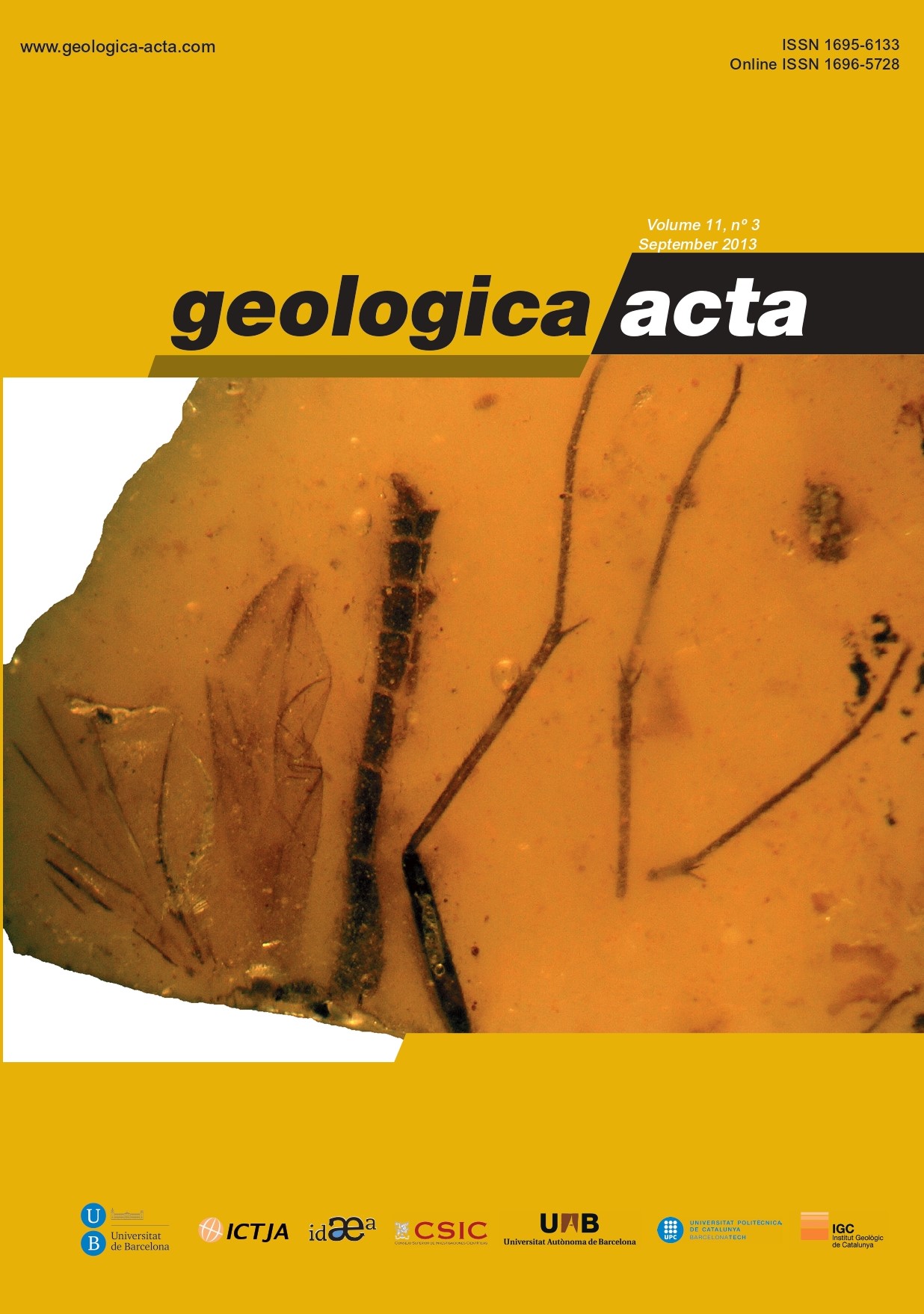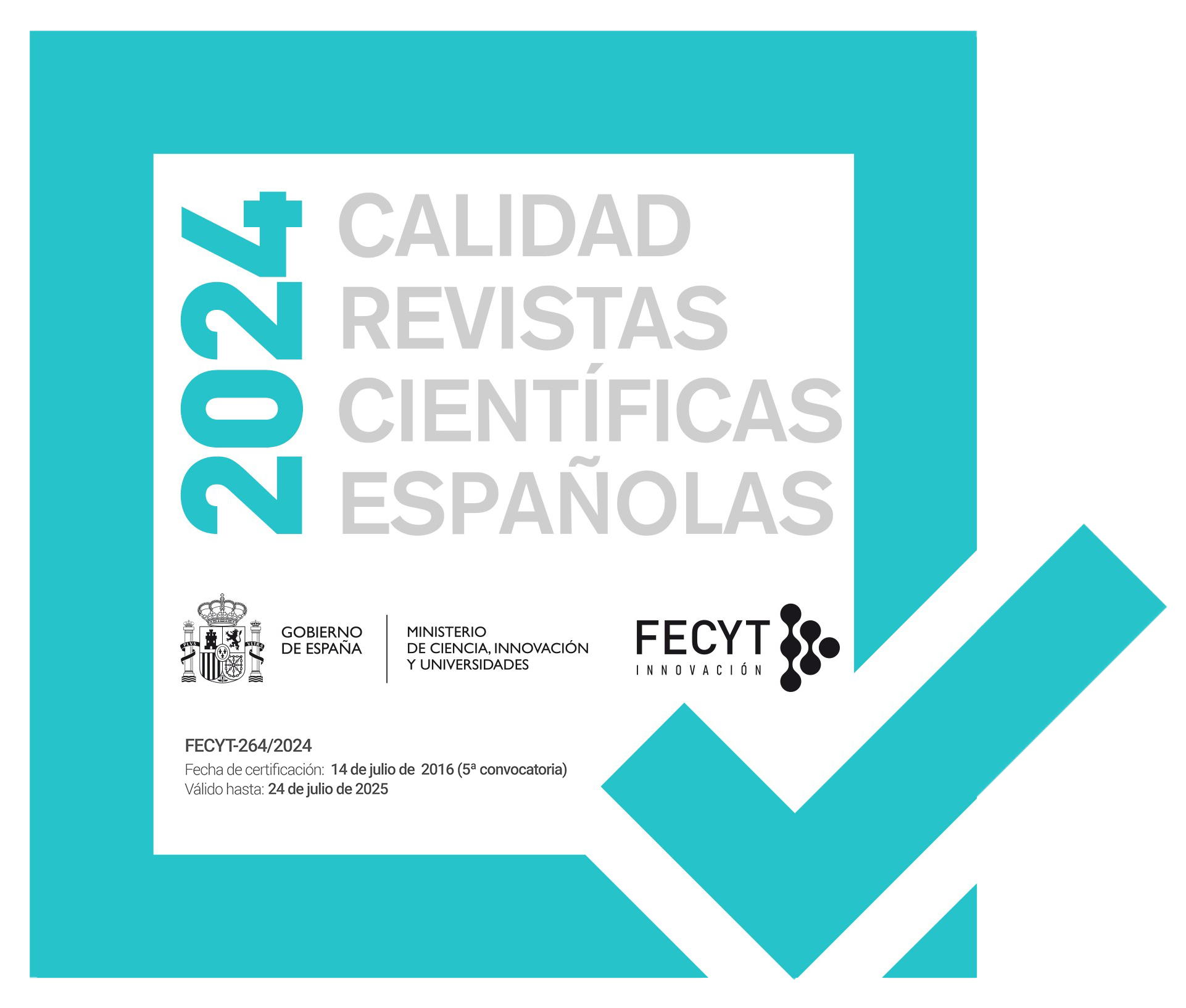Palaeoecology of the Cenomanian amber forest of Sarthe (western France)
DOI:
https://doi.org/10.1344/105.000001873Keywords:
Amber, Arthropods, Microorganisms, Palaeoecology, Cenomanian.Abstract
Cretaceous ambers have been discovered in France since the beginning of the 18th century. The best known are those from south-western France which are Late Albian-Early Cenomanian in age, but there are other important amber deposits in other regions. Here, we summarise the data on one of these other Cretaceous amber regions, the Sarthe Department. These deposits have been mentioned in the literature since the end of the 18th century, but they have remained relatively unknown. The material, that has been studied during the 1970’s and 1980’s, yielded a well-diversified arthropod fauna (72 arthropod specimens, including arachnids, cockroaches, bugs, beetles, flies, wasps...) dated to late Early-Middle Cenomanian. In the last decade, 4 types of bacteria, a possible testate amoeba and fungal remains were also found. A re-examination of the historical collections of the Sarthe amber, housed in the “Musée Vert” (Le Mans, France), allows to estimate the geographical extent of the amber deposits in the Sarthe Department. The study of the microfossils of these samples provides new data on their palaeoenvironment.
References
Adl, S.M., Simpson, A.G.B., Farmer, M.A., Andersen, R.A., Anderson, O.R., Barta, J.R., Bowser, S.S., Brugerolle, G., Fensome, R.A., Fredericq, S., James, T.Y., Karpov, S., Kugrens, P., Krug, J., Lane, C.E., Lewis, L.E., Lodge, J., Lynn, D.H., Mann, D.G., McCourt, R.M., Mendoza, L., Moestrup, Ø., Mozley-Standridge, S.E., Nerad, S.E., Shaerer, C.A., Smirnov, A.V., Spiegel, F.W., Taylor, M.F.J.R., 2005. The new higher level classification of eukaryotes with emphasis on the taxonomy of protists. Journal of Eukaryotic Microbiology, 52, 299-451.
Adl, S.M., Girard, V., Breton, G., Lak, M., Maharning, A., Mills, A., Perihcot, V., Trionnaire, M., Vullo, R., Néraudeau, D., 2011. Reconstructing the soil food web of a 100 million-yearold forest: the case of the mid-Cretaceous fossils in the amber of Charentes (SW France). Soil Biology and Biochemistry, 43, 726-735.
Azema, C., Durand, S., Médus, J., 1972. Des miospores du Cénomanien moyen. Paléobiologie Continentale, 3, 1-54.
Breton, G., 2007. La bioaccumulation de microorganismes dans l’ambre: analyse comparée d’un ambre cénomanien et d’un ambre sparnacien, et de leurs tapis algaires et bactériens. Comptes Rendus Palevol, 6,125-133.
Breton, G., Tostain, F., 2005. Les microorganismes de l’ambre cénomanien d’Écommoy (Sarthe, France). Comptes Rendus Palevol, 4, 31-46.
Cattaneo, G., Mourgues, R., 2009. Carte géologique simplifiée de la Sarthe 1:800000. Le Mans, Musée Vert du Mans, unpublished.
Crié, L., 1884. Contribution à l’étude de la flore crétacée de l’Ouest de la France. Paris, Comptes Rendus de l’Académie des Sciences, 99, 511-513.
Delaunay, P., 1934. Le sol sarthois. Ses historiens, son histoire géologique, sa géographie botanique, économique, historique et politique. Fascicule 4. Les zones crétacées. Le Mans, Ch. Monnoyer, 545-762.
Downes, A., Wirth, W.W., 1981. Ceratopogonidae, Chapter 28. In: McAlpine, J.F., Peterson, B.V., Shewell, G.E., Teskey, H.J., Vockeroth, J.R., Wood, D.M. (eds.). Manual of Neartic Diptera, Agriculture Canada Monograph 27, 1, 393-422.
Durand, S., Louail, J., 1971. Découverte d’un dépôt cénomanien fossilifère à Neau (Mayenne). Paris, Comptes Rendus de l’Académie des Sciences, 273, 1179-1181.
Foissner, W., Schönborn, W., Wright, A.D.G., Lynn, D.H., 1999. Further studies on fossilized ciliates (Protozoa, Ciliophora) from Triassic amber. In: Tajovský, K., Pil, V. (eds.). Soil zoology in Central Europe. Cezch Republic, Academy of Science of the Czech Republic, České Budĕjovice, 45-52.
Galippe, V., 1920. Recherches sur la résistance des microzymas à l’action du temps et sur leur survivance dans l’ambre. Paris, Comptes Rendus de l’Académie des Sciences, 170, 856-858.
Girard, V., 2010. Microcénoses des ambres médio-crétacés français. Taphonomie, Systématique, Paléoécologie et Reconstitution du paléoenvironnement. Mémoires Géosciences Rennes, 134, 1-294.
Girard, V., Schmidt, A.R., Saint Martin, S., Struwe, S., Perrichot, V., Saint Martin, J.P., Grosheny, D., Breton, G., Néraudeau, D., 2008. Evidence for marine microfossils from amber. Proceedings of the National Academy of Sciences of the United States of America, 105, 17426-17429.
Girard, V., Breton, G., Brient, L., Néraudeau, D., 2009a. Sheathed prokaryotic filaments, major components of mid Cretaceous French amber microcenosis. Journal of Paleolimnology, 42, 437-447.
Girard, V., Néraudeau, D., Breton, G., Saint Martin, S., Saint Martin, J.P., 2009b. Contamination of amber samples by recent microorganisms and remediation evidenced by Mid-Cretaceous amber of France. Geomicrobiology Journal, 26, 21-30.
Girard, V., Néraudeau, D., Adl, S.M., Breton, G., 2011. Protistlike inclusions in amber, as evidenced by Charentes amber. European Journal of Protistology, 47, 59-66.
Juignet, P., 1974. La transgression crétacée sur la bordure orientale du Massif armoricain. Aptien, Albien, Cénomanien de Normandie et du Maine. Le stratotype du Cénomanien. Doctoral Thesis. University of Caen, unpublished, 806 pp.
Juignet, P., Médus, J., 1971. Les argiles noires d’Écommoy (Sarthe): Précisions sédimentologiques et palynologiques. Comptes Rendus Sommaires de la Société Géologique de France, 6, 310-312.
Juignet, P., Louail, J., 1987. Transgression et régressions au Crétacé (France et régions voisines). Mémoires Géologiques de l’Université de Dijon, 11, 31-45.
Juignet, P., Kennedy, W.J., Lebert, A., 1978. Le Cénomanien du Maine: formations sédimentaires et faunes d’Ammonites du Stratotype. Géologie Méditerranéenne, V, 87-99.
Juignet, P., Damotte, R., Fauconnier, D., Kennedy, W.J., Magniez-Jannin, F., Monciardini, C., Odin, G.S., 1983. Etude de trois sondages de la région-type du Cénomanien. La limite Albien-Cénomanien dans la Sarthe (France). Géologie de la France, 3, 193-234.
Kühne, W.G., Kubig L., Schlüter, T., 1973. Eine Micropterygide (Lepidoptera, Homoneura) aus mittelkretazischem Harz Nordwestfrankreichs. Mitteilungen der Deutschen Entomologischen Gesellschaft, 32, 61-64.
Lacroix, A., 1910. Résines fossiles. In: Lacroix, A. (ed.). Minéralogie de la France et de ses colonies. Description physique et chimique des minéraux. Etude des conditions géologiques de leurs gisements. Paris, Libraire Polytechnique, Tome quatrième, 637-645.
Laing, J.F., 1975. Mid-Cretaceous angiosperm pollen from southern Europe and northern France. Palaeontology, 18, 775-808.
Lasseur, E., 2008. La Craie du Bassin de Paris (CénomanienCampanien, Crétacé supérieur). Sédimentologie de faciès, stratigraphie séquentielle et géométrie 3D. Mémoires Géosciences Rennes, 129, 1-409.
Matile, L., 1981. Description d’un Keroplatidae du Crétacé moyen et données morphologiques et taxinomiques sur les Mycetophiloidea (Diptera). Annales de la Société Entomologique de France, 17, 99-123.
Maulny, L., 1799. Histoire naturelle. Annuaire du département de la Sarthe pour l’année VIIIIe de l’ère française, 8, 39-47.
Najarro, M., Peñalver, E., Pérez de la Fuente, R., Ortega-Blanco, J., Menor-Salván, C., Barrón, E., Soriano, C., Rosales, I., López del Valle, R., Velasco, F., Tornos, F., Daviero-Gómez, V., Gómez, B., Delclòs, X., 2010. Review of the El Soplao amber outcrop, Early Cretaceous of Cantabria, Spain. Acta Geologica Sinica, 84, 959-976.
Néraudeau, D., 2005. Faune et flore des bassins paraliques. Comptes Rendus Palevol, 4, 1-6.
Néraudeau, D., Perrichot, V., Dejax, J., Masure, E., Nel, A., Philippe, M., Moreau, P., Guillocheau, F., Guyot, T., 2002. Un nouveau gisement à ambre insectifère et à végétaux (Albien terminal probable): Archingeay (Charente-Maritime, France). Geobios, 35, 233-240.
Pérez de la Fuente, R., Delclòs, X., Peñalver, E., Arillo, A., 2011. Biting midges (Diptera: Ceratopogonidae) from the Early Cretaceous El Soplao amber (N Spain). Cretaceous Research, 32, 750-761.
Perrichot, V., 2005. Environnements paraliques à ambre et à végétaux du Crétacé nord-aquitain (Charentes, Sud-Ouest de la France). Mémoires Géosciences Rennes, 125, 1-310.
Perrichot, V., Girard, V., 2009. A unique piece of amber and the complexity of ancient forest ecosystems. Palaios, 24, 137-139.
Perrichot, V., Nel, A., Krzemiński, W., 2007a. A new crane fly (Diptera: Limoniidae) from the Cretaceous amber of France. Alavesia, 1, 75-80.
Perrichot, V., Néraudeau, D., Nel, A., De Ploëg, G., 2007b. A reassessment of the Cretaceous amber deposits from France and their palaeontological significance. African Invertebrates, 48, 213-227.
Schlüter, T., 1978. Zur Systematik und Palökologie harzkonservierter Arthropoda einer Taphozönose aus dem Cenomanium von NW-Frankreich. Berliner Geowissenschaftliche Abhandlungen, Reihe A, 9, 1-150.
Schlüter, T., 1983. A fossiliferous resin from the Cenomanian of the Paris and Aquitanian basins of northwestern France. Cretaceous Research, 4, 265-269.
Schlüter, T., 1989. Neue Daten über harzkonservierte Arthropoden aus dem Cenomanium NW-Frankreichs. Documenta Naturae, 56, 59-70.
Schlüter, T., Stürmer, W., 1982. X-ray examination of fossil insects in Cretaceous amber of NW France. Annales de la Société Entomologique de France, 18, 527-529.
Schmidt, A.R., Schäfer, U., 2005. Leptotrichites resinatus new genus and species: a fossil sheathed bacterium in Alpine Cretaceous amber. Journal of Paleontology, 79, 175-184.
Schmidt, A.R., Dilcher, D. J. 2007. Aquatic organisms as amber inclusions and examples from a modern swamp forest. Proceedings of the National Academy of Sciences of the United States of America, 104, 16581-16585.
Szadziewski, R., 2004. Biting midges (Diptera: Ceratopogonidae) from Burmese amber, Myanmar. Journal of Systematic Palaeontology, 2, 115-121.
Szadziewski, R., Schlüter, T., 1992. Biting mites (Diptera: Ceratopogonidae) from Upper Cretaceous (Cenomanian) amber of France. Annales de la Société Entomologique de France, 28, 73-81.
Waggoner, B.M., 1994. An aquatic microassemblage from Cenomanian amber of France. Lethaia, 27, 77-84.
Downloads
Published
Issue
Section
License

This work is licensed under a Creative Commons Attribution-ShareAlike 4.0 International License.
Copyright
Geologica Acta is the property of the UB, GEO3BCN, IDAEA and UAB. Geologica Acta must be cited for any partial or full reproduction. Papers are distributed under the Attribution-Share Alike Creative Commons License. This license allows anyone to reproduce and disseminate the content of the journal and even make derivative works crediting authorship and provenance and distributing possible derivative works under the same or an equivalent license.
Author Rights
Authors retain the copyright on their papers and are authorized to post them on their own web pages or institutional repositories. The copyright was retained by the journal from the year 2003 until 2009. In all cases, the complete citation and a link to the Digital Object Identifier (DOI) of the article must be included.
The authors can use excerpts or reproduce illustrations of their papers in other works without prior permission from Geologica Acta provided the source of the paper including the complete citation is fully acknowledged.




